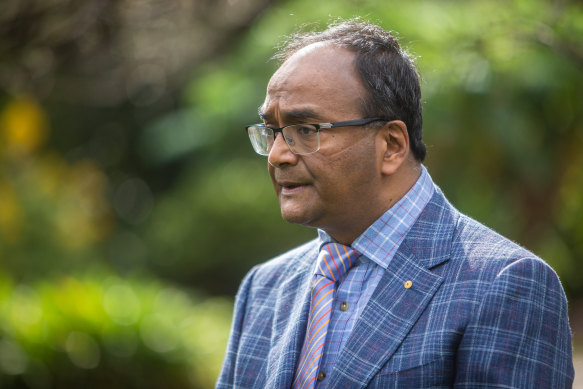This was published 2 years ago
Medical regulator ‘unaccountable to public they are meant to be protecting’
By Dana Daniel
The Australian Health Practitioner Regulation Agency has rejected allegations it has failed to protect the public from so-called “cosmetic cowboys”, amid a growing push for a royal commission into the industry.
A joint Sydney Morning Herald, The Age, 60 Minutes investigation this week revealed hundreds of cosmetic surgery patients across Australia have been left disfigured, in pain and psychologically damaged by under-regulated doctors operating with little or no oversight.

Dr Mukesh Haikerwal wants a royal commission into AHPRA.Credit: Scott McNaughton
However, the authority’s chief executive Martin Fletcher declined an interview request about the latest revelations, deferring to a spokeswoman who rejected the allegation of a conflict of interest because it received funding from the industry it is responsible for overseeing.
AHPRA’s annual report shows it receives $222 million in registration and application fees in 2021, with medical practitioners each paying about $780 a year.
The authority, a statutory body set up by state and federal health departments, is not funded by government but received some pandemic-related Commonwealth grants.
“We act independently and in the public interest and there are community members on every national, state and territory board,” the spokeswoman said. “Most regulatory systems worldwide are funded by the profession.”
Documents obtained as part of the investigation into the $1.4 billion cosmetic surgery industry expose serious failings in a sector that allows doctors with basic medical degrees and weekend courses to call themselves cosmetic surgeons.
Former Australian Medical Association president Dr Mukesh Haikerwal said he was “stunned” and “repulsed” by the latest revelations, which the regulator had failed to prevent.
Haikerwal, who is leading a push for the AMA to back calls for a royal commission into the regulator, said the authority was pursuing individual doctors over “vexatious” complaints while allowing multi-millionaire cosmetic surgeons to operate with impunity.
“They’re scared of the doctors who are litigious,” he said.
University of Melbourne Professor of Surgery Mark Ashton said AHPRA was “unaccountable to the public they are meant to be protecting” and the agency had “an inherent conflict of interest” because was funded by fees from medical practitioners.
Ashton said the authority’s funding model was a disincentive for it to withdraw unscrupulous cosmetic surgeons’ registration and he said a new, independent regulator was needed.
“If they knock people off their membership base, if they take away people’s registration, then they decrease their numbers, which decreases their revenue stream,” he said.
Federal Health Minister Mark Butler has promised to put closer regulation of the cosmetic surgery industry on the agenda at future health ministers’ meetings with his state and federal counterparts, as patient advocates call for a royal commission into health regulation.
Ashton said cosmetic surgery, which is performed in the private system, should be subject to the same clinical standards as public hospitals – a change that would result in unscrupulous operators being unable to run their businesses.
The AHPRA spokeswoman said it was waiting for an independent inquiry it ordered into cosmetic surgery to report before its chief executive would face the media.
“People have been harmed and the cosmetic surgery industry has failed consumers,” the spokeswoman said.
“We look forward to taking strong action to address the problems that we have the power to solve, guided by the independent review.”
The spokeswoman said AHPRA had placed restrictions on every cosmetic surgeon named in the 60 Minutes program and could only investigate practitioners if it was notified of misconduct.
Patricia Hall, a member of AHPRA’s community reference group, told last year’s Senate inquiry into the authority that its approach was “completely reactionary”. The inquiry heard AHPRA received almost 10,000 notifications a year.
AHPRA’s annual report says the authority’s top six executives earned a combined $2.2 million in 2021, an average of more than $364,000 each.
The spokeswoman said senior executive salaries were set by the Agency Management Committee within AHPRA’s board and were in line with remuneration in the public service.
Make the most of your health, relationships, fitness and nutrition with our Live Well newsletter. Get it in your inbox every Monday.